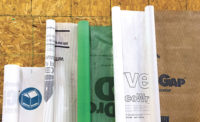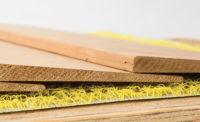Code authorities, key industry innovators and even savvy homeowners will all respond with a resounding “yes,” especially as demand for energy efficiency, environmental sustainability and an occupant’s desire for a durable, long-lasting home continues to rise. These homes should usually last for more than 200 years, according to “Retooling the U.S. Housing Industry: How It Got Here, Why It’s Broken, and How to Fix It.”
Exterior foam board use has been growing as part of the push towards high performance. In the United States, exterior foam board insulation in above-ground builds has gained significant momentum as a solution that has been proven to prevent thermal bridging—where framing creates a higher heat transfer ratio relative to the space around it. In turn, it can markedly improve R-value, reduce energy loss through studs and decrease the potential for condensation with wood sheathing.
Interestingly, this trend was initially driven by European energy codes such as Germany’s 2009 Energy Conservation Regulations and The Bouwbesluit 2012 in the Netherlands. For years, building professionals across the pond have been using exterior insulation to meet these strict code standards and create tight wall assemblies that optimize energy efficiency, environmental sustainability and occupant comfort.
But even experienced building professionals can overlook the inherent risks with increasing exterior insulation, chief among them is moisture failure. Exterior foam board can often restrict outward drying, which can introduce rot, mold and mildew into the wall assembly. Moisture problems are even worse when inward drying is restricted. Without the right drainage system between the foam board and the sheathing, insulated wall assemblies are in danger of the negative impacts of lower drying potential. The EIFS industry saw these effects firsthand through the mid-2000s but learned from its oversight and moved from face-sealed or barrier products to drained systems.
If you’re planning to go high-performance with your building envelope, here are three reasons why you’ll want to consider a provision for drainage and drying between foam board and wood sheathing:
Mitigate risks
There are two things to consider regarding the sustainability of your wall assembly. First, you need to know if condensation will occur at the sheathing. Typically, that depends on the thickness of the foam board and the climate you’re building in. Second, you’ll need to know if a water entry event will occur. Another resounding “yes.”
Regardless of whether condensation occurs, plan for moisture intrusion. No wall assembly is installed perfectly: materials move, caulks fail, flashings are lapped improperly, etc. Still, you can protect your structure by building in a small gap that allows bulk water to exit to the bottom of the wall assembly without tangibly affecting R-value, keeping your envelope on track to be ‘high performance.’
Standard housewraps typically work against this goal by clinging to foam board and presenting the same sorts of moisture build-up that the EIFS industry has worked hard to avoid. A drainable housewrap with a built-in 1mm gap has been tested as the perfect width for high-performance drainage. Similarly, grooved, exterior foam boards offer an insulation opportunity where the build can stabilize a home’s indoor environment and provide adequate drainage in the process.
Build beyond code
No matter where you build, you’ll have to plan for a unique set of weather conditions that have the potential to affect the integrity of your structure. Code mandates such as the 2015 International Residential Code, which sets standard insulation at a minimum of R-19, may require you to insulate the level beyond standard wood framing. Others, such as the current Oregon Residential Building Code, require a drainable housewrap to be installed as part of the assembly. Regardless of code, moisture management is more than just a contingency plan if you want a high-performing structure that will outlast the elements.
In order to prevent moisture failure and achieve your building goals, you’ll want to select materials that are stress-tested in an installed state to ASTM 1363, taking into consideration airflow and other factors. HydroGap drainable housewrap and the HalfbackH20 grooved foam board system are two products that have responded well in this kind of testing environment, increasing the likelihood expected product performance will mirror reality.
Set yourself apart
Combining a drainage system with exterior foam board is a commitment to a best building practice, which hopefully mirrors the execution that proves you’re serious about creating a high-performing building that will last. Even with a proliferation of education and training courses, as well as the high standard set by today’s building professionals, it’s still incumbent upon every building professional to avoid the common installation mistakes that will affect the integrity of your building.
Coupled with a drainage barrier that allows for drainage and drying, it’s now possible to create a tight wall assembly that will optimize energy efficiency, environmental sustainability and occupant comfort while avoiding the possibility of expensive remediation due to a water-entry event. Because, yes, a high-performance envelope IS a must-have.









Report Abusive Comment